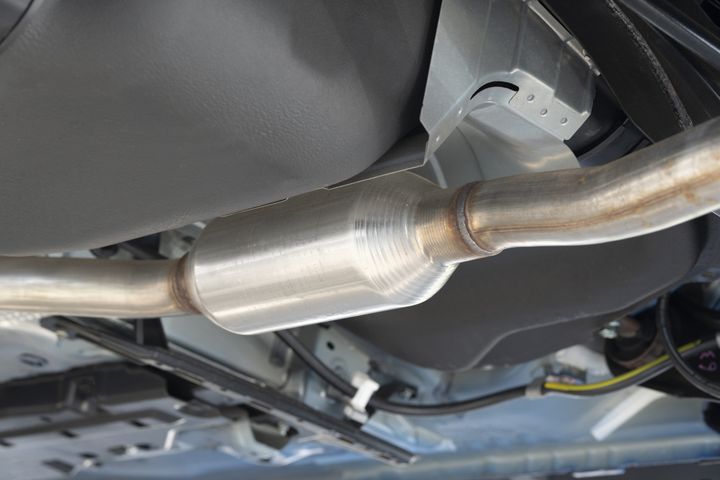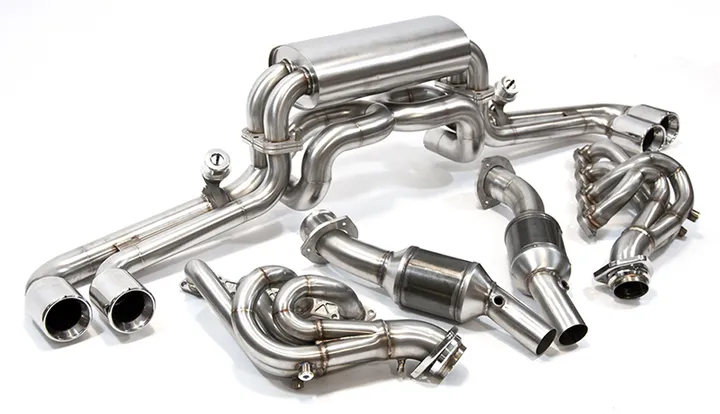


Automotive exhaust systems play a crucial role in managing harmful emissions and ensuring efficient vehicle performance. While stainless steel is often lauded as the premium choice, mild steel, also known as carbon steel, has emerged as an affordable and durable alternative for many car manufacturers and budget-conscious consumers. This article delves into the intricacies of mild steel car exhaust systems, examining their properties, advantages, applications, and considerations for maintenance and longevity.

Mild steel, an alloy primarily composed of iron and carbon, has a carbon content ranging from 0.05% to 0.25%. This composition strikes a balance between strength and ductility, making mild steel a versatile material suitable for various applications, including automotive exhaust systems.
| Property | Description |
|---|---|
| Carbon Content | 0.05% - 0.25% |
| Tensile Strength | Good |
| Ductility | Moderate |
| Heat Resistance | Suitable for non-performance vehicles |
| Corrosion Resistance | Low, susceptible to corrosion and rusting |
The carbon content in mild steel plays a crucial role in determining its properties. With a relatively low carbon percentage, mild steel exhibits good tensile strength and durability, enabling it to withstand the harsh conditions of an exhaust system, such as high temperatures and vibrations. While not as heat-resistant as stainless steel, mild steel can handle the high temperatures generated by exhaust gases, especially in non-performance vehicles or applications with moderate temperature ranges.
However, mild steel is susceptible to corrosion and rusting when exposed to moisture and certain environmental conditions. To mitigate this issue, protective coatings or treatments, such as aluminizing or galvanizing, can be applied to enhance corrosion resistance.
One of the primary advantages of mild steel is its affordability compared to other materials like stainless steel. This cost-effectiveness makes mild steel an attractive option for automotive manufacturers seeking to reduce production costs without compromising performance. Additionally, mild steel is relatively easy to fabricate and weld, simplifying the manufacturing process and further reducing costs.
Mild steel exhaust systems offer several advantages that contribute to their popularity in the automotive industry.
Affordability and Budget-Friendly Options
Good Strength and Durability for Daily Driving
Moderate Heat Resistance for Non-Performance Vehicles
Mild steel exhaust systems are significantly more cost-effective than their stainless steel counterparts, making them a popular choice for budget-conscious consumers or entry-level vehicles. This affordability allows car manufacturers to offer competitively priced models without sacrificing essential exhaust system functionality.
Despite being less expensive, mild steel exhaust systems offer good strength and durability, capable of withstanding the rigors of daily driving conditions. Their tensile strength and resistance to vibrations ensure reliable performance in typical driving scenarios.
While not as heat-resistant as stainless steel, mild steel can handle the high temperatures generated by exhaust gases in most non-performance vehicles. This makes mild steel exhaust systems suitable for a wide range of passenger cars and entry-level models.
Mild steel exhaust systems are commonly found in stock exhaust systems for passenger vehicles, particularly in entry-level or non-performance models. They are used in various exhaust components, including:
Exhaust manifolds
Exhaust pipes
Mufflers
Other exhaust components
While mild steel exhaust systems offer a cost-effective solution for everyday driving needs, they may not be suitable for high-performance applications or extreme conditions. Stainless steel systems are generally preferred for high-performance vehicles or applications with extreme temperatures or harsh environments due to their superior corrosion resistance and durability.

To maximize the lifespan of a mild steel exhaust system, proper maintenance and care are essential. Regular inspections and prompt repairs of any corrosion or damage can help prevent further deterioration. Additionally, protective coatings or treatments can enhance the corrosion resistance of mild steel exhaust systems, such as:
Aluminizing
Galvanizing
The lifespan of a mild steel exhaust system can vary depending on several factors:
Driving conditions
Exposure to harsh environments (e.g., road salt, moisture)
Quality of the system itself
In general, mild steel exhaust systems may require replacement more frequently than their stainless steel counterparts, especially in areas with severe weather conditions or high humidity.
When considering replacement, it is essential to weigh the cost of a new mild steel exhaust system against the potential benefits of upgrading to a more durable and corrosion-resistant stainless steel system, particularly if the vehicle is expected to be driven for an extended period or in harsh environments.
| Property | Mild Steel | Stainless Steel |
|---|---|---|
| Corrosion Resistance | Low | High |
| Durability | Good | Excellent |
| Heat Resistance | Moderate | High |
| Cost | Affordable | Premium |
While mild steel exhaust systems are more affordable, stainless steel systems offer superior corrosion resistance and durability. Stainless steel is more resistant to harsh environments and can withstand higher temperatures, making it the preferred choice for high-performance vehicles or applications with extreme conditions.
However, stainless steel exhaust systems come at a higher cost, which may not be justifiable for non-performance vehicles or budget-conscious consumers. The decision between mild steel and stainless steel often comes down to a balance between cost, performance requirements, and expected lifespan.
Mild steel, or carbon steel, exhaust systems offer an affordable and durable solution for many automotive applications. While they may not match the longevity and corrosion resistance of stainless steel systems, they provide a cost-effective option for budget-conscious consumers or entry-level vehicles. Proper maintenance and care can help extend the lifespan of mild steel exhaust systems, making them a practical choice for everyday driving needs. Ultimately, the selection of an exhaust system material depends on factors such as performance requirements, environmental conditions, and cost considerations.
Mild steel and carbon steel are essentially the same material. Carbon steel is the broader term, while mild steel refers specifically to low-carbon steel alloys with a carbon content between 0.05% and 0.25%.
The low carbon content in mild steel provides a balance of strength and ductility, making it suitable for exhaust systems. Higher carbon content would increase strength but reduce ductility.
Common protective coatings for mild steel exhaust systems include aluminizing and galvanizing, which enhance corrosion resistance.
Mild steel exhaust systems generally have a shorter lifespan compared to stainless steel due to their lower corrosion resistance. Proper maintenance is crucial for extending their lifespan.
Mild steel exhaust systems are not typically recommended for high-performance vehicles due to their moderate heat resistance and lower durability compared to stainless steel.
Driving conditions, exposure to harsh environments (e.g., road salt, moisture), and the quality of the system itself can all impact the lifespan of a mild steel exhaust system.
Yes, mild steel exhaust systems can be repaired or replaced if they become damaged or corroded. Replacement may be more cost-effective in some cases.
The main advantages of mild steel exhaust systems are their affordability, good strength and durability for daily driving, and moderate heat resistance for non-performance vehicles.
Mild steel is generally easier and more cost-effective to fabricate and weld compared to stainless steel, simplifying the manufacturing process.
Factors to consider include cost, performance requirements, expected lifespan, and environmental conditions the vehicle will be exposed to.

Sarah isn't your average gearhead. With a double major in Mechanical Engineering and Automotive Technology, she dived straight into the world of car repair. After 15 years of turning wrenches at dealerships and independent shops, Sarah joined MICDOT to share her expertise and passion for making cars run like new. Her in-depth knowledge and knack for explaining complex issues in simple terms make her a valuable asset to our team.








